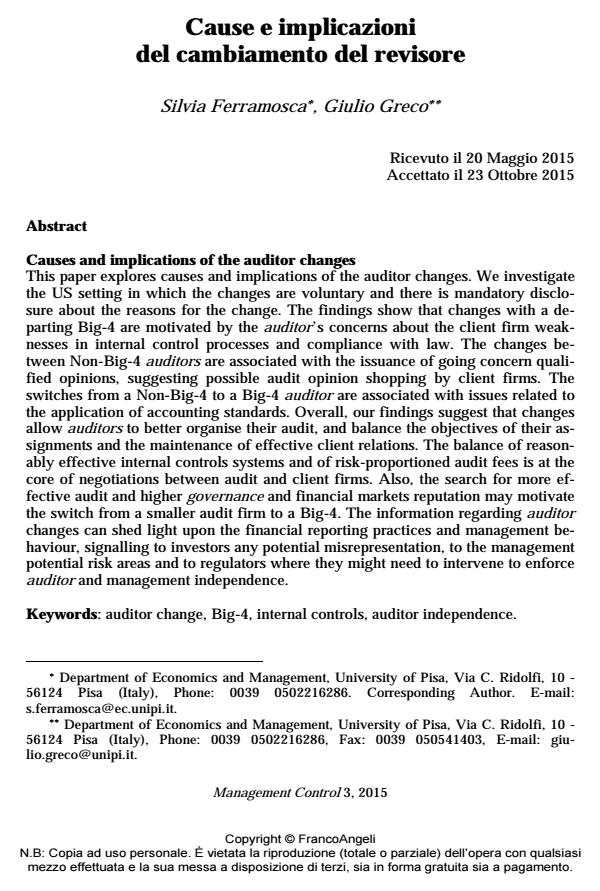Cause e implicazioni del cambiamento del revisore
Titolo Rivista MANAGEMENT CONTROL
Autori/Curatori Silvia Ferramosca, Giulio Greco
Anno di pubblicazione 2015 Fascicolo 2015/3
Lingua Italiano Numero pagine 23 P. 93-115 Dimensione file 136 KB
DOI 10.3280/MACO2015-003006
Il DOI è il codice a barre della proprietà intellettuale: per saperne di più
clicca qui
Qui sotto puoi vedere in anteprima la prima pagina di questo articolo.
Se questo articolo ti interessa, lo puoi acquistare (e scaricare in formato pdf) seguendo le facili indicazioni per acquistare il download credit. Acquista Download Credits per scaricare questo Articolo in formato PDF

FrancoAngeli è membro della Publishers International Linking Association, Inc (PILA)associazione indipendente e non profit per facilitare (attraverso i servizi tecnologici implementati da CrossRef.org) l’accesso degli studiosi ai contenuti digitali nelle pubblicazioni professionali e scientifiche
This paper explores causes and implications of the auditor changes. We investigate the US setting in which the changes are voluntary and there is mandatory disclosure about the reasons for the change. The findings show that changes with a departing Big-4 are motivated by the auditor’s concerns about the client firm weaknesses in internal control processes and compliance with law. The changes between Non-Big-4 auditors are associated with the issuance of going concern qualified opinions, suggesting possible audit opinion shopping by client firms. The switches from a Non-Big-4 to a Big-4 auditor are associated with issues related to the application of accounting standards. Overall, our findings suggest that changes allow auditors to better organise their audit, and balance the objectives of their assignments and the maintenance of effective client relations. The balance of reasonably effective internal controls systems and of risk-proportioned audit fees is at the core of negotiations between audit and client firms. Also, the search for more effective audit and higher governance and financial markets reputation may motivate the switch from a smaller audit firm to a Big-4. The information regarding auditor changes can shed light upon the financial reporting practices and management behaviour, signalling to investors any potential misrepresentation, to the management potential risk areas and to regulators where they might need to intervene to enforce auditor and management independence.
Parole chiave:Auditor change, Big-4, internal controls, auditor independence
- Esiste una strategia di Internal Auditing che crea valore? Un'analisi empirica del contesto italiano Giuseppe D'Onza, Alessandra Rigolini, Francesco Brotini, in MANAGEMENT CONTROL 1/2016 pp.125
DOI: 10.3280/MACO2016-001008 - Un framework integrato per la misura dell'innovazione del Piano Nazionale Scuola Digitale (PNSD) Domenico Consoli, Selena Aureli, in MANAGEMENT CONTROL 1/2018 pp.139
DOI: 10.3280/MACO2018-001007
Silvia Ferramosca, Giulio Greco, Cause e implicazioni del cambiamento del revisore in "MANAGEMENT CONTROL" 3/2015, pp 93-115, DOI: 10.3280/MACO2015-003006